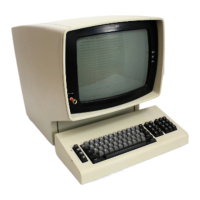Tab Key. Pressing the Tab key moves the cursor to the right to
H~e
first
character location
of
the next input field. In the top example in Figure 3-21,
the cursor
is
located in the field entitled "ADDRESS". The operator has
just finished keying
"RED ROAD, ARVADA, COLORADO" and could now
press the Tab key
to
move the cursor quickly to the next input field, "DATE",
to
begin keying in that information.
In
the examples
in
Figure 3-21, pressing
the
Tab
key when the cursor
is
located at A moves the cursor to
B.
Pressing the Tab key moves the cursor to the first location on line I
if
the screen
is
not formatted or if there are no input fields. Tab also has typamatic capability
that
allows you
to
move the cursor quickly from field to field.
SKIP
Key
(Data Entry Keyboard Only). The purpose and the operation
of
the SKIP key are identical with those
of
the Tab key (refer to the descrip-
tion
of
the Tab key). Both keys have typamatic capability that allows you
to
move the cursor quickly from field to field. This duplication
of
function
is
provided for operator convenience. The Tab key
is
on the left side
of
the
keyboard, and the SKIP key
is
nearer the right side.
Figure 3-21. Tab
Key
Operations
3-28

